Sangria for Wine Lovers
The fine-wine cognoscenti might sometimes turn their vino-sniffing noses
up at the thought of sangria, a combination of wine and fruit that aims
for refreshment and fun over complexity and haughtiness. That’s a shame,
because sangria is not only pure party material but also has a rich history
of its own and enough variation to please just about any palate. If you
doubt its seriousness, bear in mind that, just as there are specific
stemware designs for wines made from certain grape varieties and in
different regions, sangria now has its own dedicated glass!
Sangria’s origins probably date back to the Middle Ages,
during a time when water was unhealthy to drink and drinking
fermented beverages carried a much lower risk of causing
illness. During this time, people would mix wine, which was much lighter and less potent than what we are
used to today, with spices such as cinnamon.
“Sangria” is the Spanish term for a mix of fruit and
wine that became popular in Europe in the subsequent centuries,
and the drink emerged on the American culinary radar when
it was served in New York at the Spanish World Area during
the 1964 World’s Fair. The word “sangria” is much more
serious than the drink itself: it comes from the Latin
word for blood, thanks to the original sangria’s reddish
hue, a result of the red wine first used to make it.
Since then, various European countries and hundreds of
restaurants have created their own variations on the
sangria theme. Spain alone offers quite a few traditional
options based on region, with sparkling recipes coming from
the areas that produce Cava, for example.
While you can buy high-quality, ready-made sangrias,
it’s also a lot of fun to start with a wine that you
enjoy and your favorite fruits and spices and take a
shot at making your own. For wine lovers, here are
some suggestions for getting into the sangria groove,
based on wine type.
Red Wine
The traditional Spanish version of sangria utilizes
wine made from Tempranillo, the grape responsible for
the famous red wines of that country’s Rioja region.
You can substitute your own favorite in place of Rioja
in just about any red wine sangria recipe. Just keep
in mind that not all red wines will take to a sangria
mix equally well. For a more drinkable sangria
concoction, look for dry red wines that are reasonably
priced and tasty and offer simple, fruit-driven flavors
and aromas. It’s best to avoid older red wines
(which are usually too delicate for mixing), tannic reds
(which might make the sangria taste astringent),
and overly complex wines (which are often more expensive
and usually best left to be consumed on their own or
paired with a meal rather than having their more interesting
aromas and flavors mixed away).
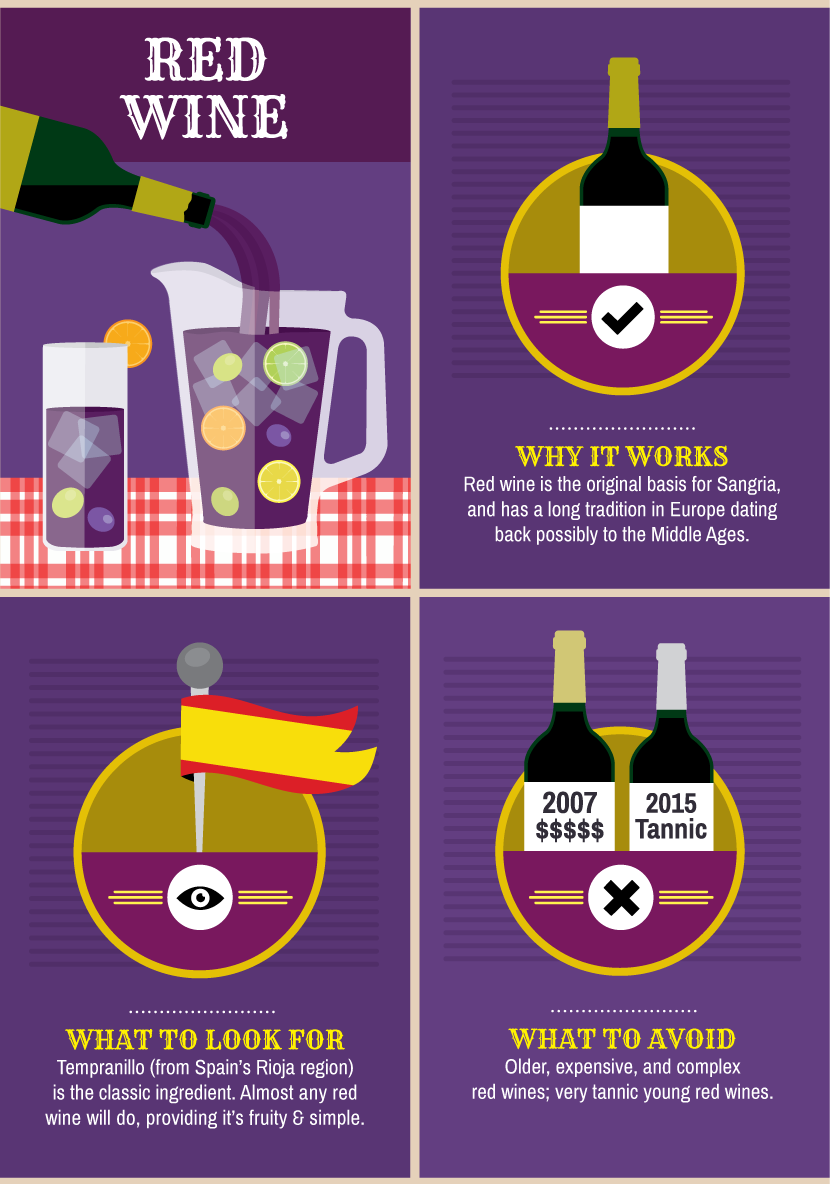
White Wine
Interestingly, it’s actually a bit harder to find the
right white wine and fruit combination for a good sangria.
This is because white wines tend to show their fruitier
side more, so you will need to pay special attention to
what grapes are used in the white wine sangria recipe
you are preparing. For example, a Sauvignon Blanc that’s
jumping with citrus aromas might not meld that well with a
sangria recipe that calls for a lot of lime and lemon, as
the total citrus and acidity might make the sangria less
appealing overall. You’ll need to experiment a bit, but
lighter, un-oaked Chardonnays tend to do well, as do Chenin
Blanc wines. As with red wine sangria recipes, you should
aim for simple and tasty and avoid older white wines,
expensive and complex white wines, and fuller-bodied white
wines like oaked Chardonnay.
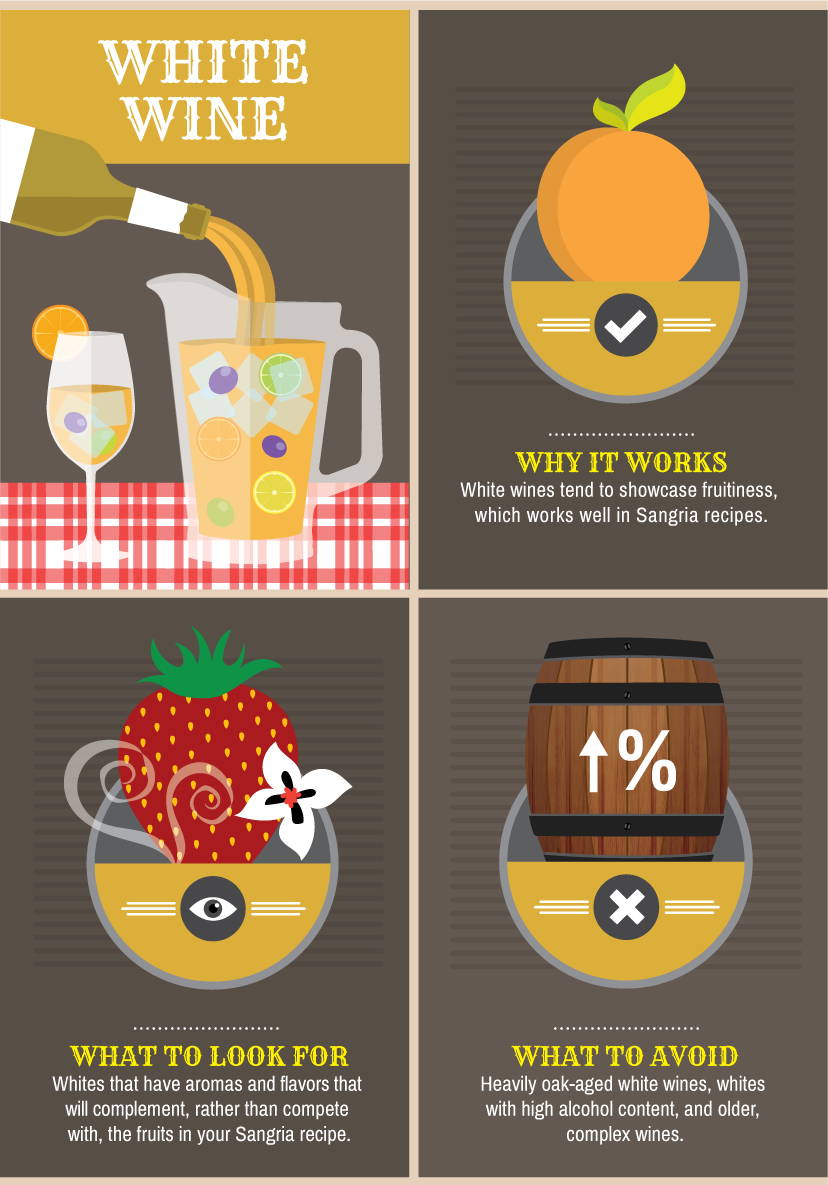
Rosé Wine
With the plethora of excellent dry rosé wines available,
don’t overlook using a pink wine for your sangria. These have
the added benefit of creating some naturally beautiful color
combinations for the resulting drink, given that rosés can be
found in every pink hue from light salmon to blood-red. Not
surprisingly, given the lighter red berry flavors and aromas
presented by many rosés, this wine type tends to do best in
sangria recipes that include raspberries, cranberries, and
peaches as the main fruit ingredient.
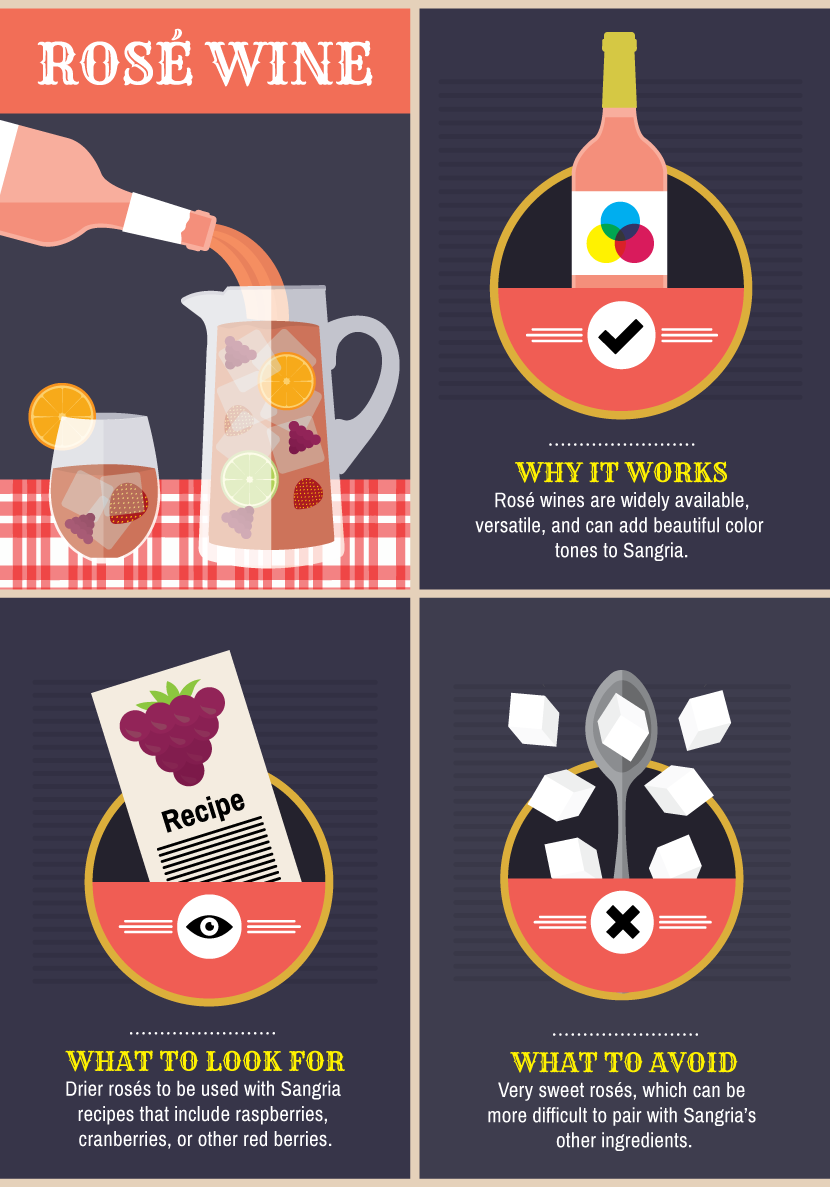
Sparkling Wine
If you’re considering giving your sangria a vivacious kick,
try using a sparkling wine in the recipe instead of still wine.
Just as with still wines, simple and fruity options will work
best; think Spanish Cava or Italian Prosecco, both of which
are good, value-priced options. Most sparkling wines will
work in sangria recipes that call for white wines, and
rosé bubblies can be substituted in sangria recipes that
include rosé still wines. The key to using sparkling wine
in sangria isn’t so much the choice of bubbly as it is how
you prepare the recipe. Many sangria recipes specify soaking
the ingredients for an extended period. While that will
help to integrate the flavors in the sangria, an extended
soak will be murder on the sparkling wine, causing it to
dissipate its bubbles. In this case, it’s best to let all
of the other ingredients combine and then open and add the
sparkling wine just before serving.
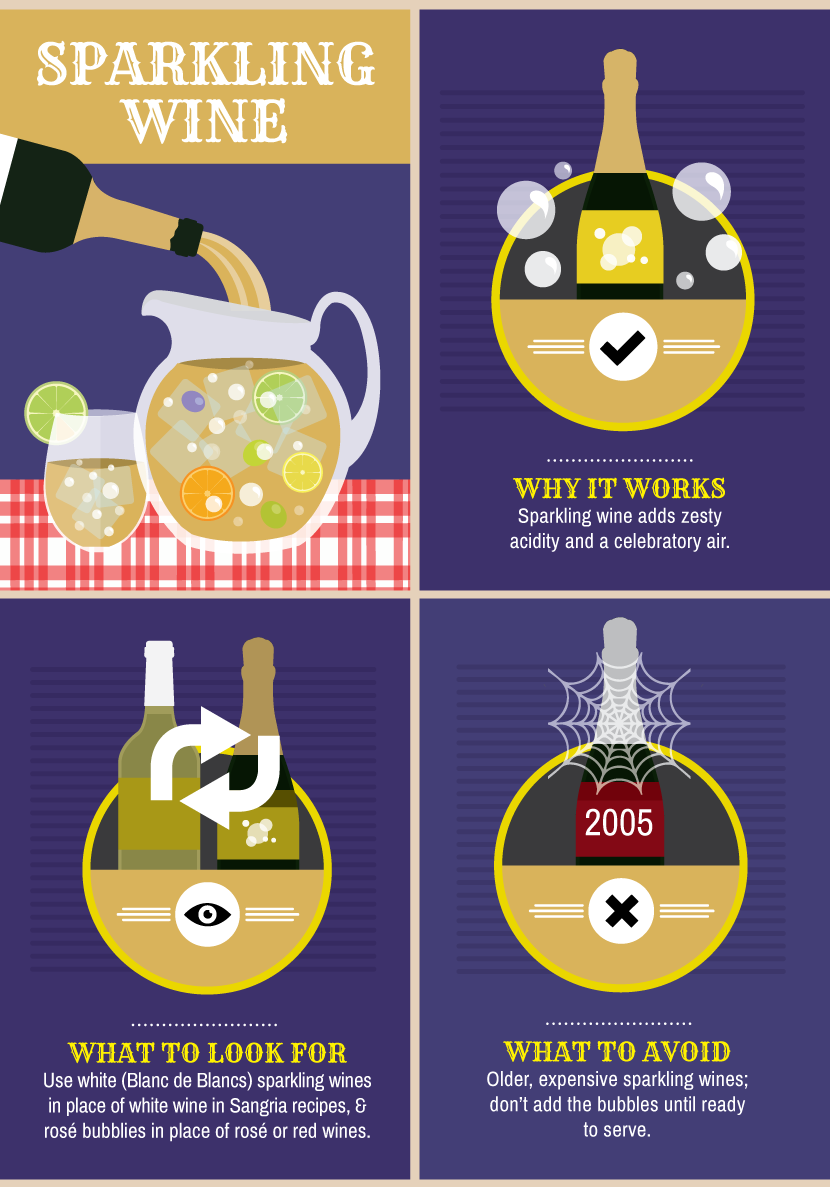
Dessert Wine
Sweet wines might not seem like a winning sangria option,
but with a little careful planning, a dessert sipper can
produce a tasty and memorable mix. The trick? Look for simple,
fruity, sweet wines that aren’t pushing the sugar levels or the
alcohol content (fortified wines like port, Madeira, and Marsala,
while excellent for some mixed drinks, are best avoided here).
To maximize your chances of a winning sangria combination when
using a sweeter wine, look for recipes that call for fruit with
a lot of mouth-puckering acidity, such as pomegranates, lemons,
oranges, and limes. That extra jolt of acidity will help to
counteract the sugar in the sweet wine, making the sangria
taste a little drier overall and improving the sense of
balance of the various ingredients when you drink it.
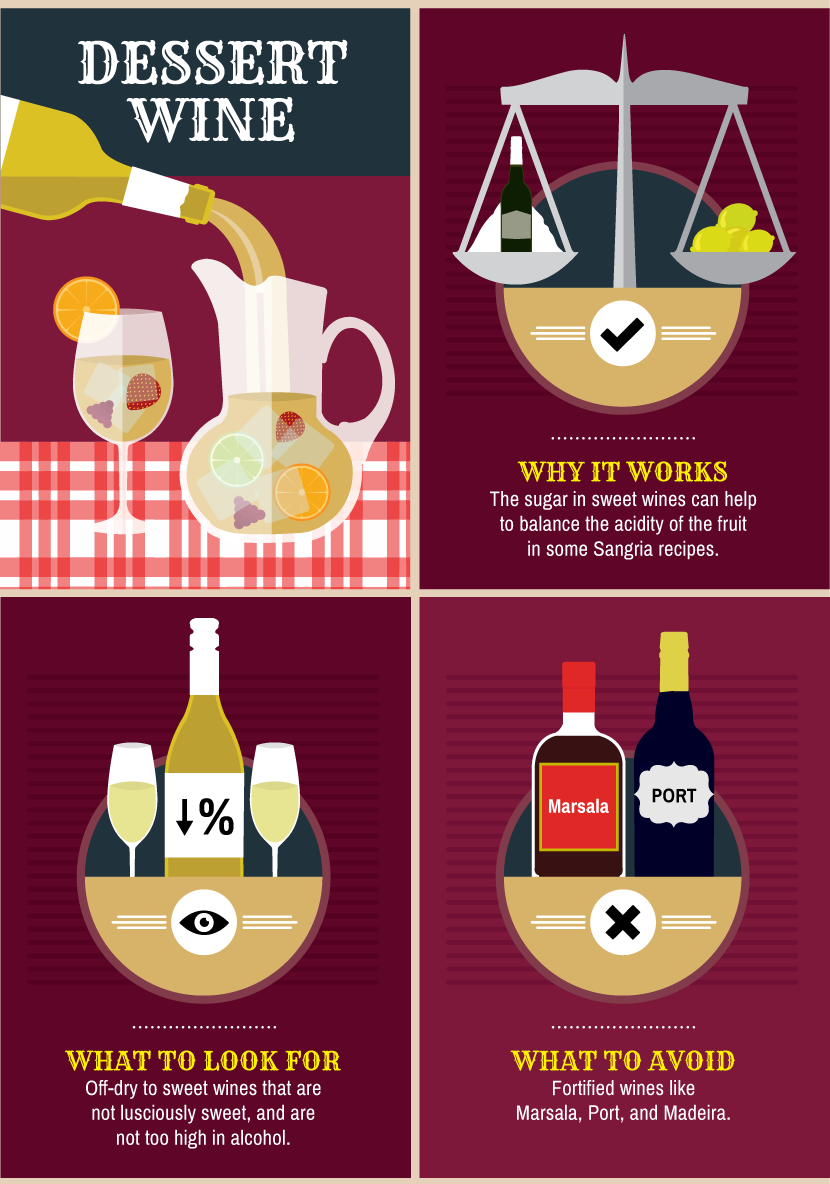 Whether you choose to use red, white, rosé, sparkling,
or dessert wine in your sangria, the process of making and
drinking this versatile drink is a great way to celebrate
the warming weather and a different, more party-oriented
take on wine this spring and summer.
Whether you choose to use red, white, rosé, sparkling,
or dessert wine in your sangria, the process of making and
drinking this versatile drink is a great way to celebrate
the warming weather and a different, more party-oriented
take on wine this spring and summer.
Embed the article on your site

